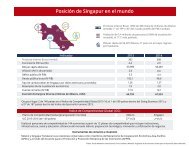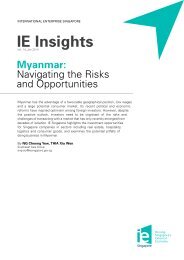basic-guide-to-exporting_Latest_eg_main_086196
basic-guide-to-exporting_Latest_eg_main_086196
basic-guide-to-exporting_Latest_eg_main_086196
You also want an ePaper? Increase the reach of your titles
YUMPU automatically turns print PDFs into web optimized ePapers that Google loves.
concepts—the wholly obtained and the substantially transformed good—may alsoapply in determining the origin of the goods for FTAs.Preferential Rules of OriginFTA ROOs are preferential rules. They are specific <strong>to</strong> each FTA and generally varyfrom agreement <strong>to</strong> agreement and from product <strong>to</strong> product. They are used <strong>to</strong> verifythat products are eligible for duty-free or reduced duties under U.S. trade preferenceprograms even though they may contain nonoriginating (non-FTA) inputs. As witha nonpreferential ROO, if goods are a “wholly obtained product” of a beneficiary ofpreference program, or FTA, establishing the origin is usually fairly straightforward.However, if a good was not entirely grown or manufactured in the targeted country/r<strong>eg</strong>ion, specific ROOs apply. For example, if paper is made entirely in the UnitedStates from U.S. trees, the paper clearly originates in the United States. However, ifenvelopes are folded and glued in the United States from paper made in Brazil, whichone is considered the country of origin? The FTA ROOs provide precise answers <strong>to</strong>such questions.Originating GoodsTo receive preferential treatment under FTAs, U.S. goods must qualify or “originate.”A good is considered <strong>to</strong> be originating if it is wholly obtained (see the definition ofwholly obtained at the end of this chapter) in the terri<strong>to</strong>ry of one of the parties <strong>to</strong> theFTA. It’s also originating if it contains foreign input but meets specific ROOs listed inparticular FTA agreements or meets other requirements specified in the agreement.Locating FTA-Specific Rules of OriginROOs are listed in FTA agreements by HS product classification numbers. Therefore,<strong>to</strong> determine which specific ROO applies, an exporter needs <strong>to</strong> identify the product’sspecific HS classification number.You can locate an HS number by looking up its U.S. Schedule B number. The first sixdigits of the Schedule B number are usually the HS number, which is recognized bycus<strong>to</strong>ms officials everywhere. To locate the Schedule B number for your product, visit1.usa.gov/1vHzesa, or call the U.S. Census Bureau at (800) 549-0595 x2.You will find the most up-<strong>to</strong>-date ROOs on the U.S. International Trade Commissionwebsite under “General Rules of Interpretation” by clicking on “General Note 12” ofthe rules. The ROOs for all of the FTAs are in one document. The list of 2014 ROOs canbe found at 1.usa.gov/1x20QLD.The ROOs are listed by chapters (first two digits of an HS number) and within aparticular chapter by the full six-digit HS code. Many of the ROOs refer <strong>to</strong> a portion ofan HS code. Each HS code may be broken up. For example, the HS code 123456 willhave chapter 12, heading 1234, and subheading 123456.204U.S. Commercial Service • A Basic Guide <strong>to</strong> Exporting





